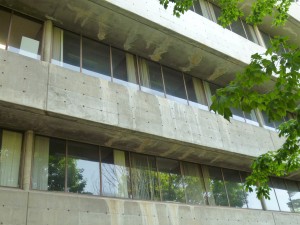
49 years old
I read an amazing (for me) fact recently. A participant in a Getty Center colloquium on building preservation casually observed that the life cycle of conventionally built (masonry and wood) buildings is about 120 years (before major repairs), whereas for modernist buildings it is only half that time—sixty years. Consider Yale’s masterpieces of the 1960s: Louis Kahn’s art gallery, Paul Rudolph’s A & A, Eero Saarinen’s colleges. They have all recently undergone major renovation, at a cost far exceeding the original construction cost. In the words of Yale dean, Robert A. M. Stern, “They cost pennies to build and millions to renovate.”
Sixty years! You might say that architects today are delivering half the product that they used to. For a long time, a building’s durability was taken for granted. It might be clad in marble, brick, or stucco, but with adequate maintenance (cleaning, re-pointing, painting and plastering), it could be expected to last. This was because construction consisted of heavy masonry walls, whether you were building a villa, a palazzo, or a basilica. This changed when reinforced concrete came into common use. The new material seemed almost magical, allowing dramatic cantilevers, shell-thin vaults, skinny columns. It took several decades to discover that steel and concrete were precarious partners, and that porous, fragile concrete was a poor substitute for stone and brick as external cladding. By then a generation of Brutalist buildings had come into being. Structural steel is durable, but the lightweight glass curtain wall has its own problems: gaskets, sealants, glass coatings. A sixty-year life? probably.
Modern architecture looks so, well modern. Efficient, engineered, precise, machine-made. Who knew? “Oh, by the way. This isn’t your grandfather’s building. Don’t expect it to be around for centuries. In fact, expect to shell out much more in sixty years to keep it going than you paid to build it. Or just knock it down. After all, it wasn’t meant to last.”

The 120-year lifespan resonates with what we were told in Amsterdam. The lovely canalside houses have to be rebuilt to such a degree each century that the cost is at least as great as rebuilding every 100 years.
The current buildings are faced with building code, EPA restrictions, energy codes and etc changes that engineers and architects know will make the buildings obsolete in less than 60 years.
Hi, Would it be possible to know the specific reference or name of the presenter in order for me to quote the 60-120 years affirmation?
Can’t recall now.May have been Susan Macdonald.
Hello,
I found this quote in an article, it looks like they are citing you, but it doesn’t say.
Is this a quote of yours?
“This is not a story of building materials, however, it is one of development. Our desire for bigger and better, safer and more fashionable, in order to increase the value of our finite land resources, especially in crowded cities, has encouraged this shorter building lifecycle. There is more money to be made from creating a building, demolishing it at 60-years-old, and rebuilding with modern methods and styles than constructing buildings to last hundreds of years. The property industry is now being placed under significant pressure to re-think their practices in this age of sustainability.”
I would love to use it in my Dissertation but I am not sure if it would be correct to cite you here.
All the best!
I do not recognize the quote. I wouldn’t use a term like “property industry” which sounds British to me. Nor do I agree with the sentiment “There is more money to be made from creating a building, demolishing it at 60-years-old, and rebuilding with modern methods and styles than constructing buildings to last hundreds of years.”